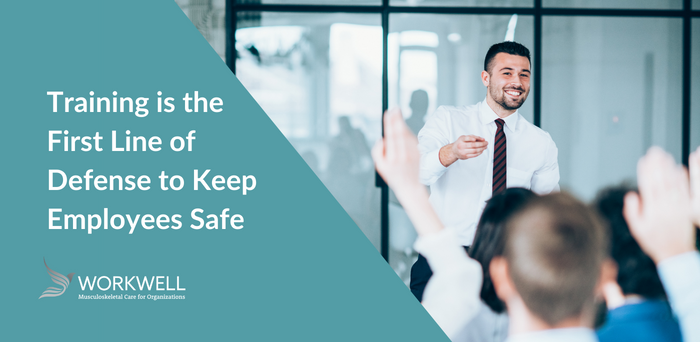Prevent It


Training is a Key Element of Employee Safety and Wellness Programs
Employee safety training is a program designed to provide workers with skills and knowledge to perform their tasks safely. When equipped with the proper know-how, your team could keep themselves safe and the people around them.
Recently, training expert Kristen Cederlind was highlighted as a training industry thought leader on TrainingIndustry.com. Click here to read the original article.
At a broad level, workplace safety training topics should include workplace ergonomics, equipment, and fire and environmental safety. Sure, you can grab some safety topic ideas from Google and check the safety training requirement box, or you can dive deeper and ensure you are creating relevant and practical safety training for your employees, which can be more effective in reducing workplace risks and hazards.
Some key tenets of adult learning include practical relevance and application to help move workers from basic knowledge to real-world application and problem-solving. As part of the training, hands-on practice is valuable for retaining key concepts.
Before rolling out a health and safety program, you must first analyze and understand workplace risks and hazards for successful risk mitigation. Job hazard analysis can take place using specific standardized tools or systems but will often include these seven steps. Quick note: The first four steps are optimal in cross-functional teams with stakeholders in the environment, health and safety (EHS), corporate leadership, and, most importantly, your workforce.
Hands-on practice, as part of the training, is valuable for the retention of key concepts.
Let's take a look at the seven steps to improving employee safety and wellness training.
- Review the data: Get the background of the issues by looking at data such as Occupational Health and Safety Administration (OSHA) injury logs, workers’ compensation injury data, industry regulatory guidance, employee observations, and/or safety meeting minutes.
- Observe the work: Spend time inspecting the workplace. Talk with the workers, identify and document any hazards (i.e., physical, ergonomic, mechanical, chemical, or biologic) and use checklists to identify what can go wrong, how it could happen, contributing factors, and consequences.
- Analyze the risk/hazard: Get to the root of the problem using a root cause analysis process (e.g., fishbone diagrams, Ishikawa diagrams, The Five Whys). Through this process, discover what happened, how it happened, and a course correction.
- Prioritize the risk/hazard: The objective is to determine the probability and severity of a hazard and plan to address the most significant issues first.
- Implement preventive measures and controls: Now it’s time to act. Leadership commitment and involvement in building a safety culture, and not just offering lip service, is critical for risk reduction plans to be effective. If unable to eliminate the risk entirely, a combination of engineering, administrative controls, and the use of personal protective equipment (PPE) can help. For maximum effectiveness, involve employees in the development of these solutions. The NIOSH hierarchy of controls is a great model to refer to.
- Training and development: This step and the last are crucial for successful implementation and evaluating the effectiveness of the implemented controls. Safety training may include a combination of scheduled classes. Don’t merely ask workers to read a fat binder of new policies. Make training practical and as hands-on as possible. Help workers understand the “why” behind a rule, not just the rule. A rule for a rule’s sake isn’t valuable or respected and can’t be internalized. The material must be useful or relevant to an employee to be internalized. They need to understand how training can secure their jobs.
- Evaluate the effectiveness: Audit the workplace and track progress (or issues) with key performance indicators (KPIs) and observations. Involve workers in this evaluation process. They will typically audit their own behavior if they are evaluating someone else. Examine elements of seeking new solutions from workers if something is not working well. Perhaps the training itself needs to be tweaked. Be open to honest feedback.
And finally, repeat the process. Continuous improvement should be a feedback loop of reviewing and renewing. When done right, job hazard analysis can become a continuous improvement process.
Having accumulated life experience, adult learners may need their perspective to be respected and valued to buy into new processes. As workplace risks are identified, engage employees in finding solutions. They are the subject matter experts (SMEs), and there’s no better way to solve a problem than by engaging those closest to the work. Not only can you gain many risk mitigation ideas, but your training efforts can also be more sustainable for the future.
Building job hazard analysis into your safety training program can help make training more engaging and relevant to workers and promote optimal workplace health and safety.
Select a topic
- View all topics
- WorkWell
- Safety Culture
- Onsite PT Clinics
- Ergonomics
- Injury/Illness Prevention
- Employee Wellness
- MSK
- Industry News
- POET
- Safety
- Managed Services
- Manufacturing
- Functional Job Descriptions
- Onsite PT
- FJD
- Post Offer Employment Training
- Provider Network
- Blog
- Events
- Featured
- OSHA
- Work Readiness
- Company News
- Job Coaching
- MSK Strategy
- Musculoskeletal
- PT Solutions Employee
- Presenteeism
- Push/Pull
- Recruitment
- Training
- Trust
- Worksite Rounds
Subscribe to Our Blog
Practical tips focused on workplace injury prevention.
Featured Posts
postsTags [BlogPost 178613021575 Shift to Prevention and End the Game of Whack-a-Mole, BlogPost 125116526205 Why now is the time for a Managed Onsite MSK Clinic]
.png)

